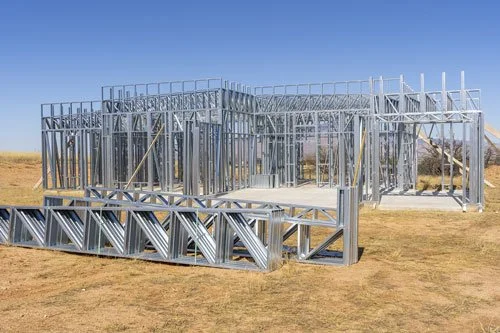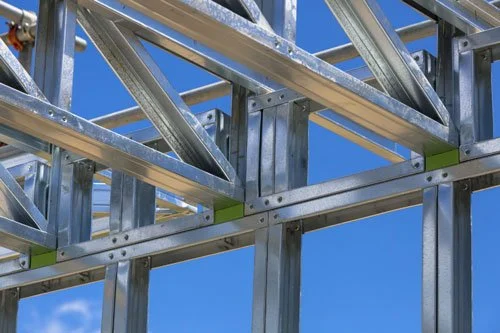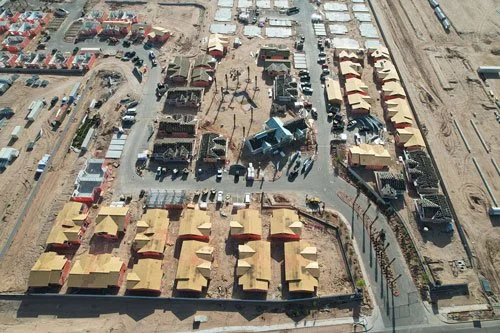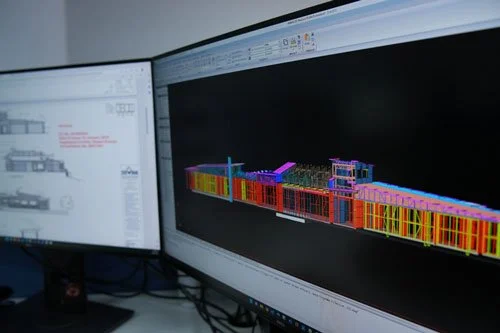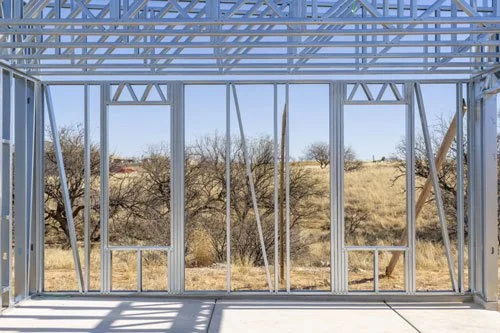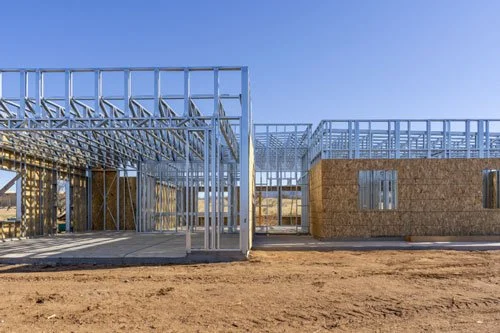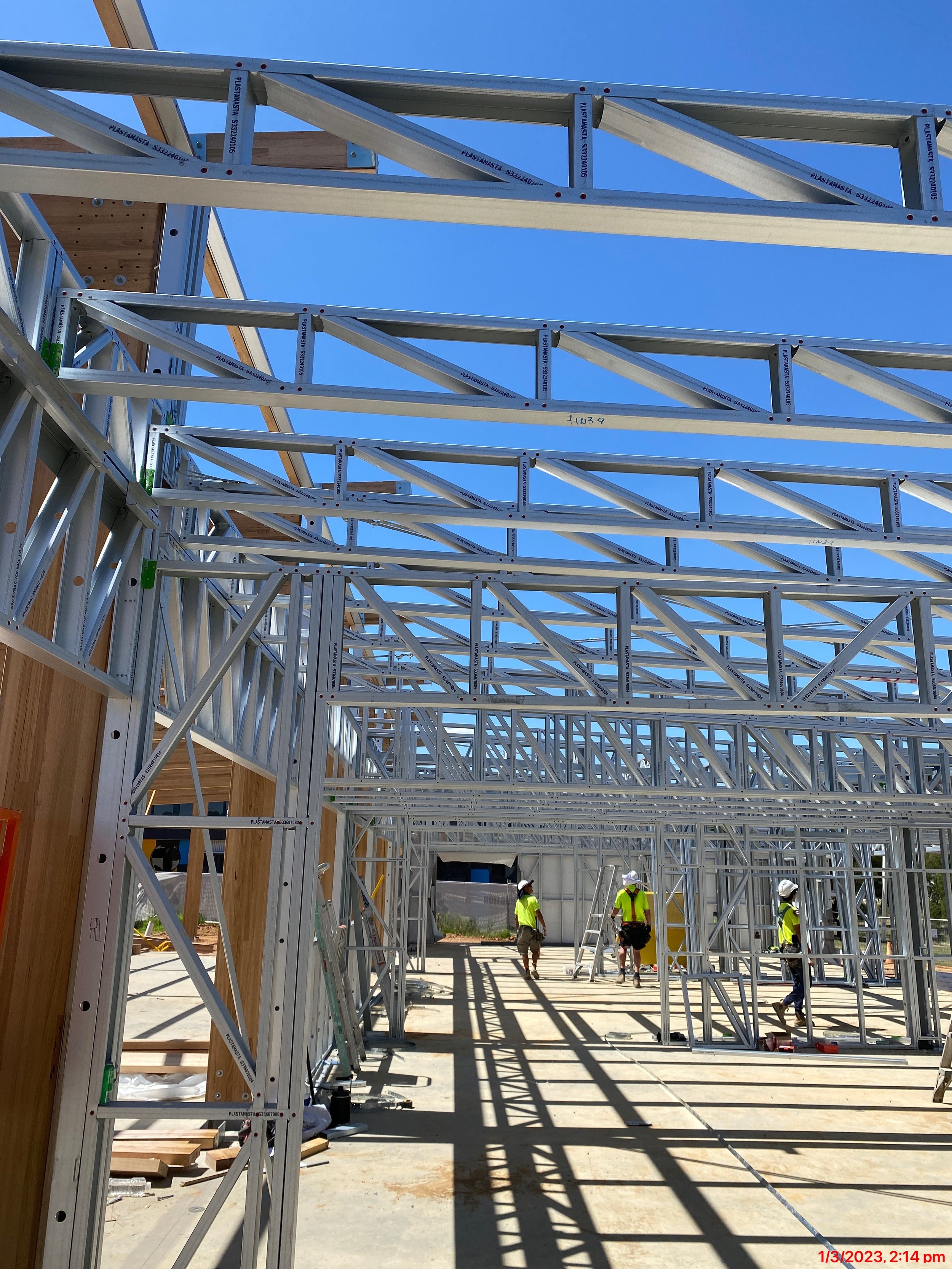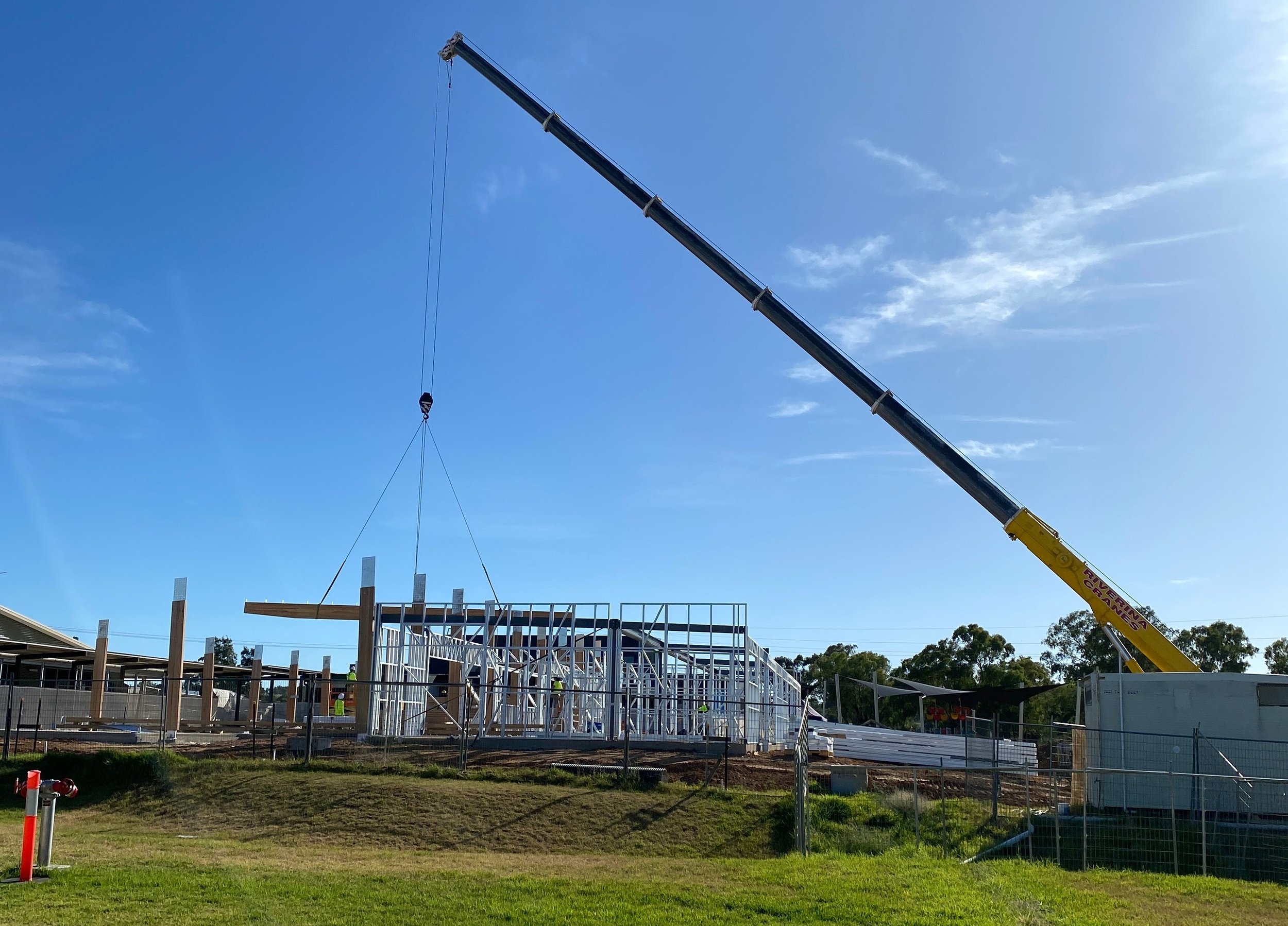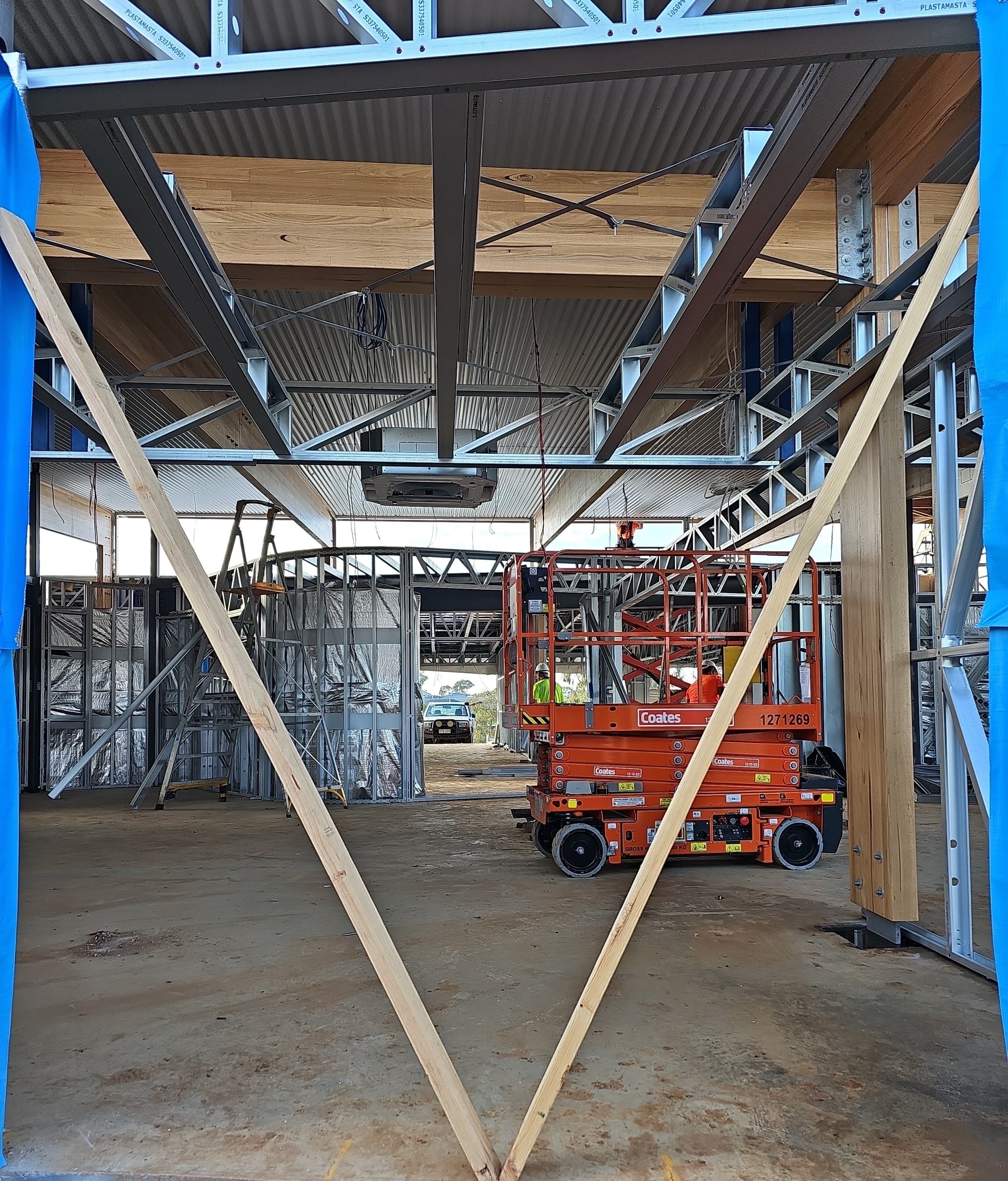TIMBER VS STEEL FRAMES: Why Builders Are Making the Switch to Steel
Why Builders Are Making the Switch to Steel
Discover the Unmatched Benefits of Steel Frames and Trusses: Your Future-Forward Solution for Durable, Efficient Construction.
Welcome to the Future of Residential Construction
If you're a timber builder, you might be wondering why there's so much buzz around FRAMECAD steel frames and trusses. Why should you, a seasoned timber builder, consider transitioning to FRAMECAD steel frames? With FRAMECAD's game-changing steel framing system, we're not just building homes; we're crafting the future. This is your chance to not only elevate your building projects but to become a pioneer in an industry ripe for innovation.
Choosing steel framing doesn't just offer you a business edge; it catapults you into the vanguard of sustainable and efficient building. Don't just follow the trend—set it. Discover limitless opportunities and carve your niche in the future of construction with FRAMECAD.
IN THIS ARTICLE:
SECTION 1: Embracing the Future of Residential Building
1.1 Enhanced Speed and Efficiency
1.2 Superior Strength and Durability
1.3 Consistent Quality and Precision
1.4 Design Flexibility
1.5 Sustainability
1.6 Long-Term Cost Savings
SECTION 2: The FRAMECAD Advantage
2.1 How FRAMECAD is Changing the Game
2.2 The Technical Edge
2.3 Speed and Efficiency
2.4 Scalability and Versatility
2.5 Integration with Modern Tools
SECTION 3: Addressing Common Concerns and Questions: Steel Frame Vs Timber Frames
3.1 "Is Steel Framing Really More Durable than Timber?"
3.2 "Isn't Steel More Expensive?"
3.3 "What About Insulation?"
3.4 "Are Steel Frames Hard to Install?"
3.5 "Is Steel a Fire Hazard?"
3.6 "How Does Steel Impact the Environment?"
3.7 "Can Steel Frames Accommodate Electrical and Plumbing Work?"
3.8 "What About Design Limitations?"
SECTION 4: Debunking Myths: Setting the Record Straight on Steel Framing
4.1 Steel is Only for Skyscrapers and Industrial Buildings
4.2 Steel Frames Make Buildings Cold
4.3 Steel Corrodes Easily
4.4 Steel is Bad for the Environment
4.5 Steel Framing is Noisy
4.6 Steel Limits Architectural Creativity
SECTION 5: Overcoming Objections: Setting Your Concerns to Rest
5.1 Cost Concerns: An Investment, Not an Expense
5.2 Skill Set and Training: Easier Than You Think
5.3 Availability of Supplies: We've Got You Covered
5.4 Versatility and Design: A New World of Opportunities
5.5 Local Codes and Regulations: Navigating the Legal Landscape
5.6 Time to Market: Speeding Up Your Construction Cycle
5.7 Environmental Impact: Steel Is Green
Conclusion: The Future is Built on Steel
How do I get started?
What are the training options?
Are steel frames environmentally friendly?
SECTION 1:
Embracing the Future of Residential Building
Switching to steel frames represents not just a choice, but a leap into the future of residential construction. In this section, we break down the core benefits of choosing steel framing over traditional timber, demonstrating why this material is the smarter, more sustainable option for your next building project.
Enhanced Speed and Efficiency
Stepping into steel framing means entering a world of automated, high-precision construction. The use of pre-engineered components and cutting-edge technology significantly accelerates construction timelines. This efficiency is a godsend for large-scale projects, where every day saved is money earned.
Superior Strength and Durability
The natural properties of steel give it a level of strength and robustness that wood simply can't match. Steel framing stands strong against extreme weather conditions, seismic activities, and the test of time, offering long-lasting structural integrity.
Consistent Quality and Precision
Steel framing offers an unmatched level of consistency, eliminating the human errors and material variations often seen in wood construction. This translates to a higher level of quality control throughout your building project.
Design Flexibility
The adaptability of steel allows for more intricate and versatile designs. With steel frames, architects and builders can let their creativity run wild, without the limitations of wood’s structural properties.
Sustainability
Choosing steel framing is choosing an environmentally conscious future. Steel is recyclable and non-combustible, reducing both waste and fire risks, thereby contributing to a sustainable construction landscape.
Long-Term Cost Savings
While the initial investment in steel may be higher than wood, the long-term financial benefits are undeniable. Reduced maintenance and resistance to rot, warping, and termites result in significant cost savings over the building's lifespan.
SECTION 2:
The FRAMECAD Advantage
The FRAMECAD system is revolutionising the construction industry, bringing unprecedented levels of efficiency, precision, and adaptability. In this section, we delve into what makes this system a game-changer for anyone looking to invest in steel framing.
2.1 How FRAMECAD is Changing the Game
By automating the design and manufacturing process, FRAMECAD has upped the ante in construction technology. This automation ensures every steel frame is engineered to exact specifications, making your building projects more efficient and accurate than ever before.
2.2 The Technical Edge
With FRAMECAD, each frame is crafted to exact measurements, which means no compromises on structural integrity. This technical prowess sets a new standard in the industry, making issues like structural weak points and alignment errors a thing of the past.
2.3 Speed and Efficiency
FRAMECAD takes your design data straight from the drawing board to the manufacturing floor. This seamless transition dramatically reduces both material waste and man-hours, enabling you to complete projects on time and within budget.
2.4 Scalability and Versatility
Whether you’re building a cosy home or a sprawling commercial complex, FRAMECAD is tailored to meet your specific needs. The system is built to accommodate any scale and any complexity, offering a one-size-fits-all solution for diverse projects.
2.5 Integration with Modern Tools
Seamless integration with current design and project management software makes FRAMECAD a collaborative powerhouse. Real-time updates and synchronised team efforts reduce the chances of costly mistakes, ensuring your projects run as smoothly as possible.
SECTION 3:
Addressing Common Concerns and Questions: Steel Frame Vs Timber Frames
3.1 "Is Steel Framing Really More Durable than Timber?"
In a word, yes. Steel offers unparalleled resistance to the common challenges that plague timber: warping, rotting, and susceptibility to pests. With steel's robustness and immunity to these issues, your construction projects stand the test of time with minimal maintenance.
3.2 "Isn't Steel More Expensive?"
While the upfront costs of steel can be higher, the long-term investment pays off through fewer repairs, lower maintenance, and long-lasting durability. Steel frames, especially those designed by FRAMECAD technology, also lead to faster construction times, which can offset initial costs through saved labour hours.
3.3 "What About Insulation?"
One misconception about steel frames is that they don't insulate as well as timber. Modern steel framing methods, combined with high-quality insulating materials like Fletcher Insulation, provide excellent thermal performance, keeping buildings cool in summer and warm in winter.
3.4 "Are Steel Frames Hard to Install?"
If you're accustomed to timber, it's natural to be concerned about a learning curve. However, the FRAMECAD system provides comprehensive training and support, ensuring that your team can quickly and effectively adapt to steel frame installation. Plus, steel frames come with pre-punched holes for easy assembly, streamlining the construction process.
3.5 "Is Steel a Fire Hazard?"
Steel is non-combustible and does not contribute to the spread of fire. In many cases, steel-framed structures have better fire ratings than their timber counterparts, making them a safer choice for both residential and commercial projects.
3.6 "How Does Steel Impact the Environment?"
Steel frames are often made from recycled material and are 100% recyclable at the end of their lifespan. Combined with sustainable practices in steel manufacturing, steel frames present an eco-friendly alternative to traditional timber.
3.7 "Can Steel Frames Accommodate Electrical and Plumbing Work?"
Steel frames, particularly those designed using FRAMECAD’s system, come with pre-punched holes for electrical and plumbing works. This makes it easy to integrate essential services into the building without compromising structural integrity.
3.8 "What About Design Limitations?"
Steel's strength-to-weight ratio opens up a plethora of design possibilities that may be challenging to achieve with timber. From vast open spaces to intricate architectural features, steel provides the versatility modern builders crave.
SECTION 4:
Debunking Myths: Setting the Record Straight on Steel Framing
Are you still on the fence about making the switch to steel framing? In this section, we address the most common objections and misconceptions you might have, offering compelling reasons why steel framing should be your go-to option.
4.1 Steel is Only for Skyscrapers and Industrial Buildings
There's a prevailing myth that steel framing is only suitable for skyscrapers or industrial projects. However, advancements in technology have made steel an increasingly popular choice for residential construction, offering strength, durability, and design flexibility that rivals traditional timber.
4.2 Steel Frames Make Buildings Cold
The myth that steel-framed buildings are cold or poorly insulated couldn't be further from the truth. When combined with modern insulating materials, steel-framed buildings can easily meet or exceed energy efficiency standards, ensuring a comfortable living environment year-round.
4.3 Steel Corrodes Easily
Many people believe that steel framing is prone to corrosion, affecting its longevity. In fact, protective coatings and advances in steel alloys have significantly increased corrosion resistance, making it a reliable material for long-term use.
4.4 Steel is Bad for the Environment
There's a common misconception that steel manufacturing is harmful to the environment. However, steel is one of the most recycled materials on the planet. With many steel frames containing recycled content and being recyclable themselves, steel is an eco-friendly building option.
4.5 Steel Framing is Noisy
Some people think that steel framing leads to noisy interiors, especially when it contracts and expands with temperature changes. Modern building practices and insulation techniques have virtually eliminated this issue, providing quiet and serene indoor spaces.
4.6 Steel Limits Architectural Creativity
This myth stems from the idea that steel's rigidity limits design options. On the contrary, the high strength-to-weight ratio of steel actually expands design possibilities, allowing for innovative structures that might be difficult, if not impossible, to achieve with timber.
SECTION 5:
Overcoming Objections: Setting Your Concerns to Rest
5.1 Cost Concerns: An Investment, Not an Expense
Many builders worry about the initial costs of switching to steel. While steel might require a higher upfront investment, the longevity and lower maintenance costs more than compensate for it. Through case studies and cost-benefit analyses, we'll show you how the math adds up in steel's favor over the long term.
5.2 Skill Set and Training: Easier Than You Think
The transition from timber to steel might seem daunting from a skill-set perspective. We'll break down how training programs and on-site support can ease this transition, making it a non-issue.
5.3 Availability of Supplies: We've Got You Covered
Concerned about the availability of steel frames and trusses? Our manufacturing capabilities ensure a consistent and timely supply of high-quality products, making supply chain disruptions a thing of the past.
5.4 Versatility and Design: A New World of Opportunities
There's a misconception that steel framing limits your design capabilities. We'll debunk this myth by showcasing a variety of projects that have used steel frames to achieve complex and beautiful designs.
5.5 Local Codes and Regulations: Navigating the Legal Landscape
Switching to a new construction material can raise questions about local building codes and regulations. This section will guide you through the process of ensuring that your steel frame project complies with all local and national standards.
5.6 Time to Market: Speeding Up Your Construction Cycle
With pre-fabricated components and streamlined construction techniques, steel actually reduces your time-to-market. We'll delve into how this quicker building cycle can be a competitive advantage for your business.
5.7 Environmental Impact: Steel Is Green
We'll address the misconception that steel is less environmentally friendly than timber. By looking at the recycling rate of steel and its longer lifespan, we'll demonstrate that steel is actually a more sustainable option.
CONCLUSION:
The Future is Built on Steel
As we've navigated through the intricacies of steel frames vs timber frames, one thing is abundantly clear: steel framing offers an array of benefits that far surpass its timber counterpart. From speed and efficiency to long-lasting durability and greater design flexibility, steel framing emerges as the clear winner for modern construction needs.
We've also debunked several myths surrounding steel framing, dispelling notions that have long plagued this innovative building method. From the false belief that steel is suitable only for industrial applications to misconceptions about its environmental impact, we've set the record straight: steel is a versatile, sustainable, and efficient building material.
Moreover, we've addressed common concerns that builders and architects often have when considering the switch to steel. From cost factors to skill set requirements, we've shown that many of these concerns are either unfounded or easily manageable with the right information and tools at your disposal.
Finally, we've delved into actionable strategies for overcoming objections and implementing steel framing in your construction projects. Whether it's navigating building codes or optimising supply chain logistics, we've provided practical guidance to make your transition to steel as seamless as possible.
So, as you plan your next building project, we invite you to consider the compelling advantages of steel framing. It's more than just a choice of material; it's a commitment to embracing innovation, prioritising sustainability, and building for the future.
How do I get started?
To get started, you can share your project plans with us to receive a tailored, free quote. Once you approve the quote, we proceed to the design phase. Here, we leverage the advanced FRAMECAD system to draft a precise 3D model of your project. Our structural engineers review every design before moving to the manufacturing stage. All this ensures that we align closely with your vision right from the outset.
What are the training options?
We understand that switching to steel frames may require a bit of a learning curve for some teams. That's why, upon delivery of your ordered components, we provide comprehensive on-site training and support. Our team will guide you through the installation process and make sure you're comfortable with the new material. We're committed to equipping your team with all the necessary knowledge to make the most out of our steel frames and trusses.
Are steel frames environmentally friendly?
Yes, steel frames are an environmentally responsible choice for construction. All of our steel frames and trusses are constructed in Wagga using 100% recycled materials, which stand as a testament to our commitment to sustainable building practices. Steel is also 100% recyclable, adding to its eco-friendly advantages. Plus, the strength and durability of steel mean less waste over the long term, making it a sustainable option for both residential and commercial projects.


